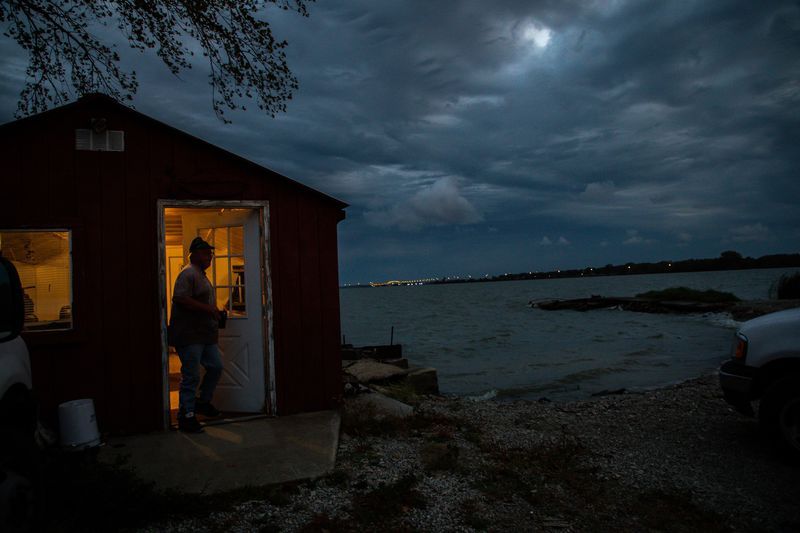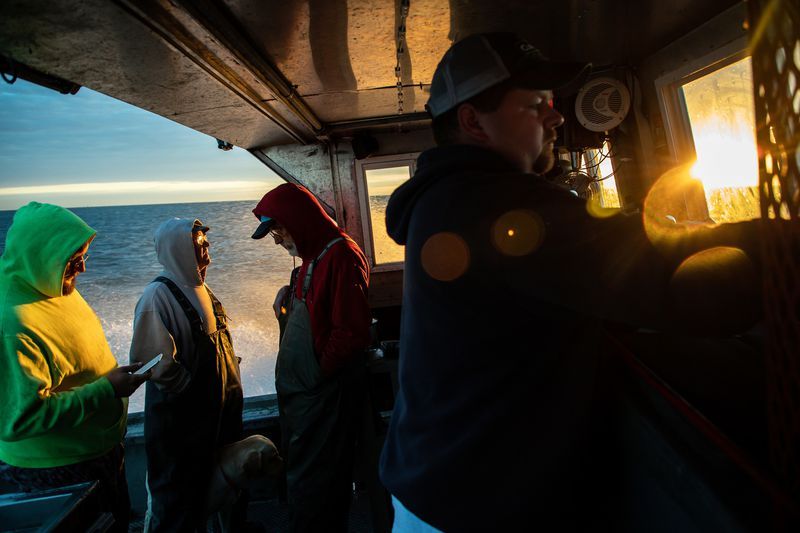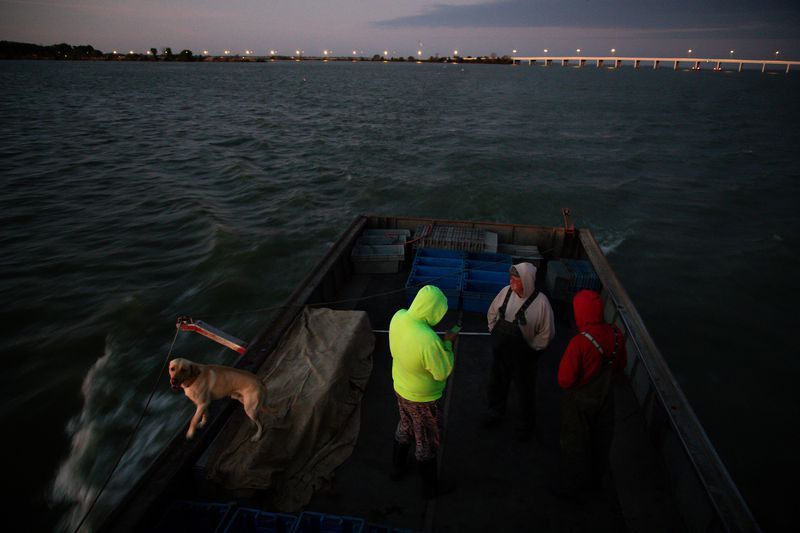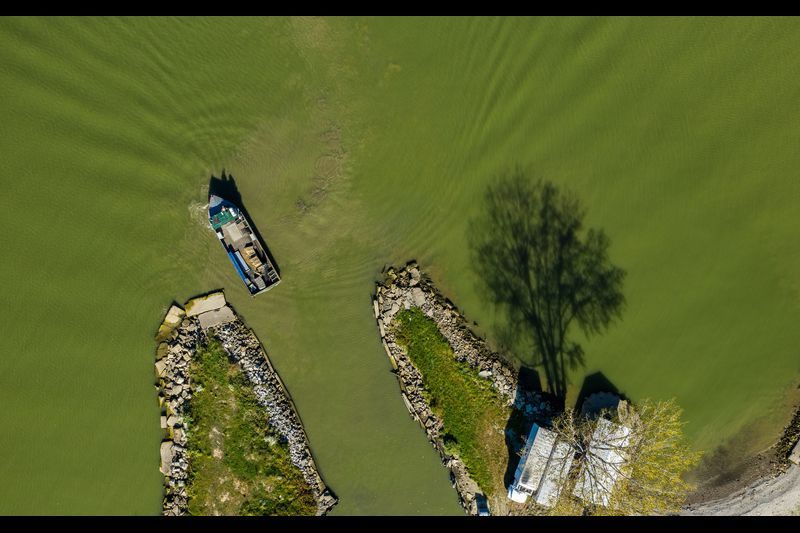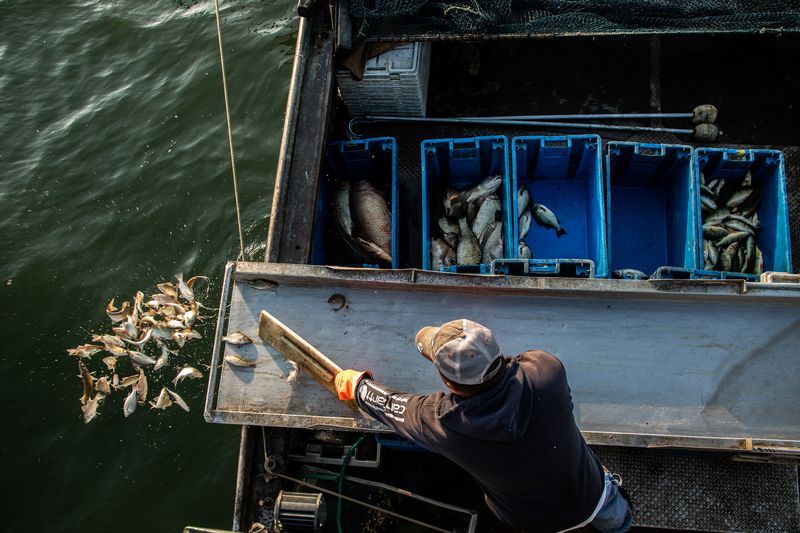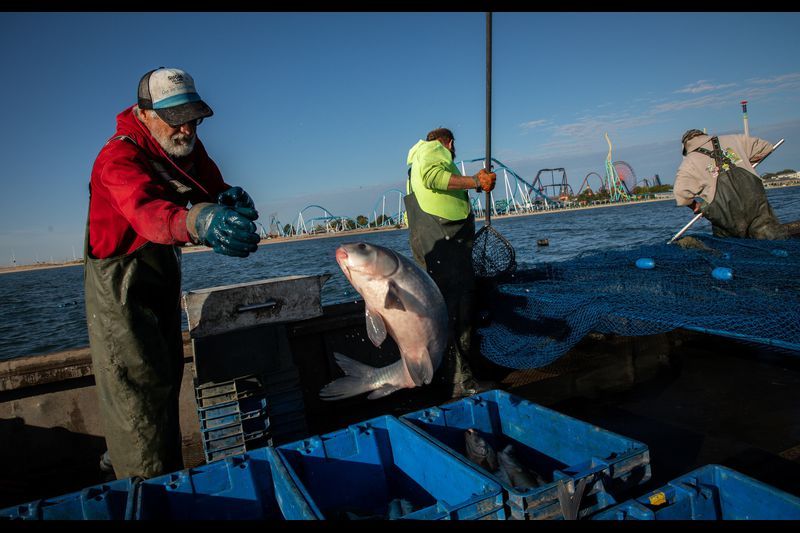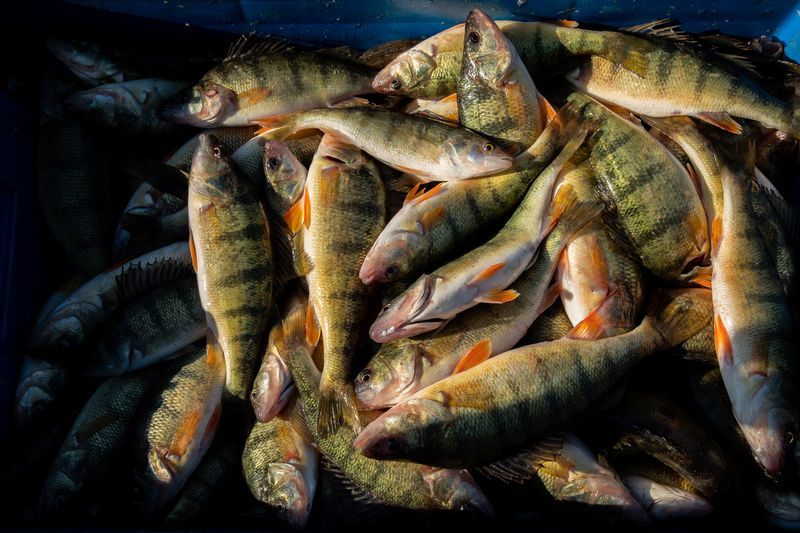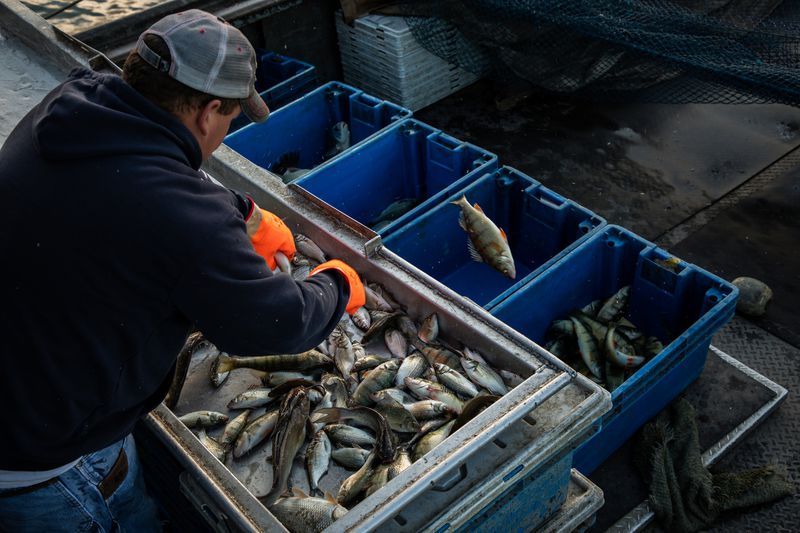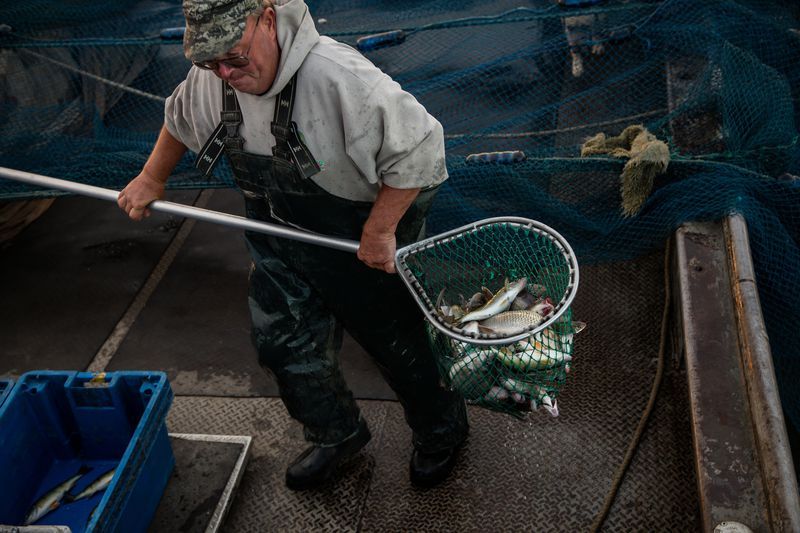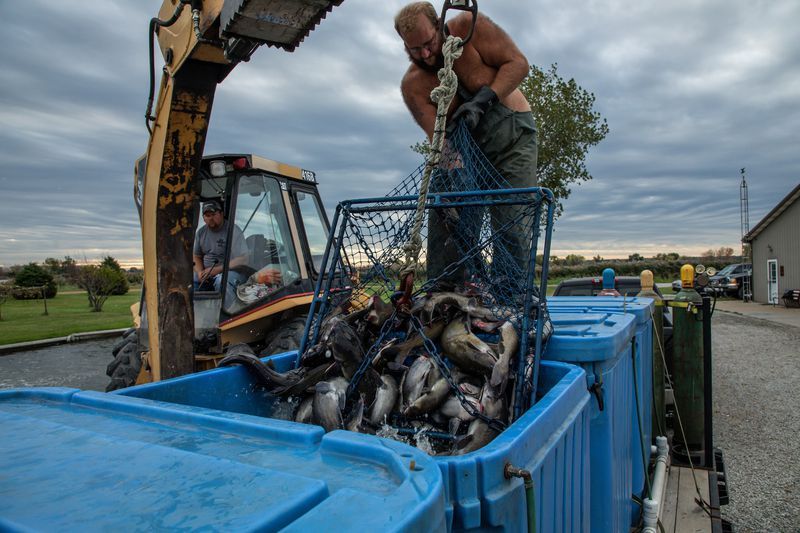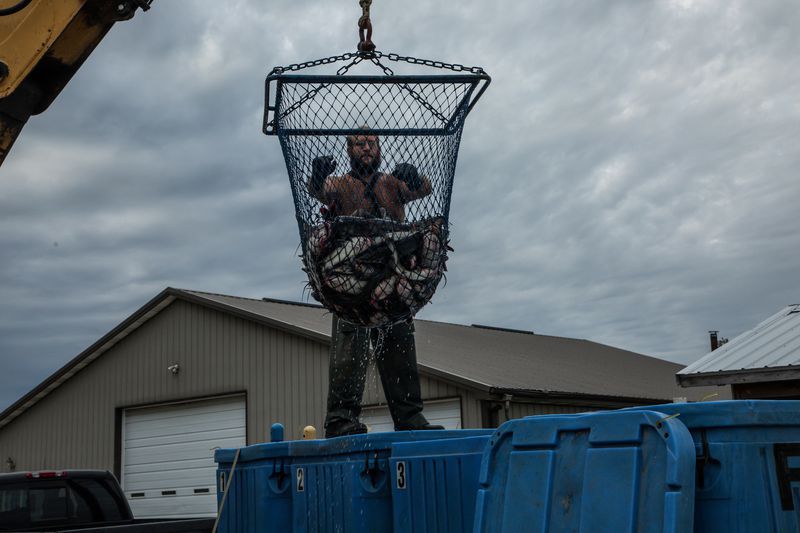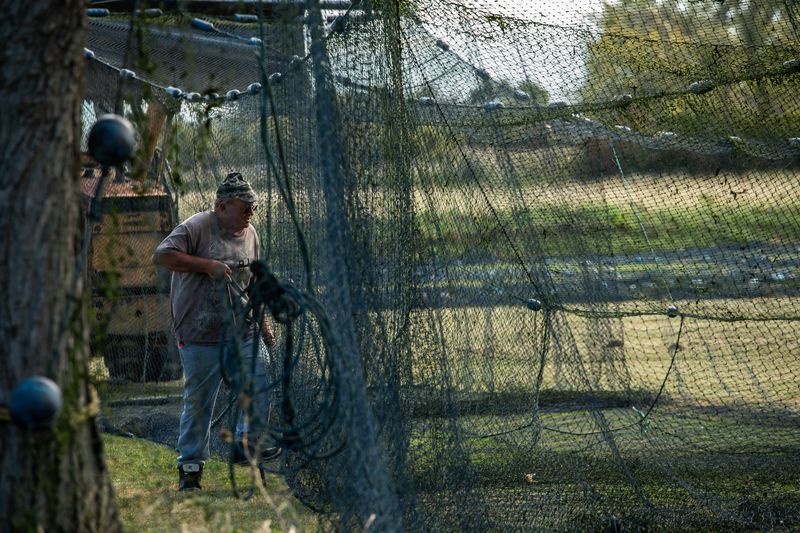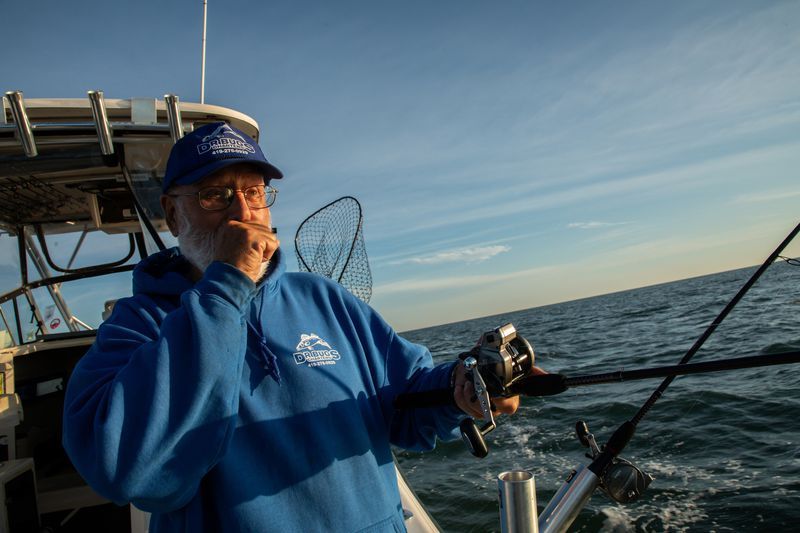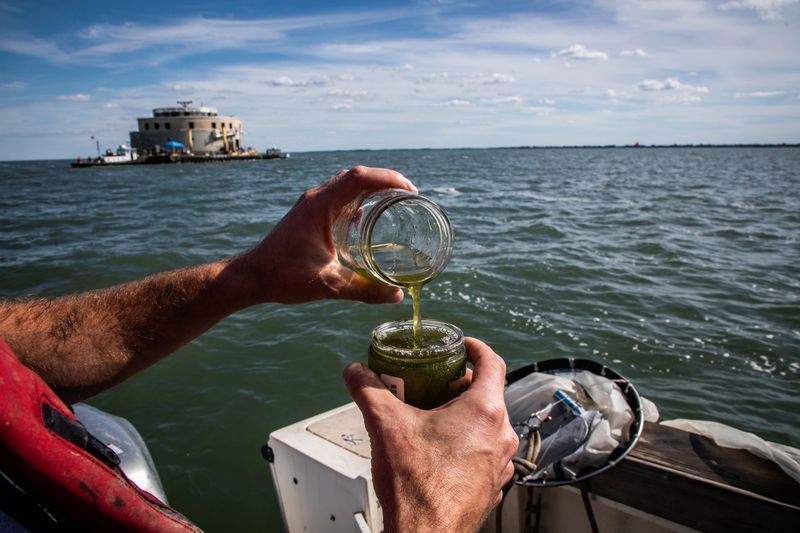From his lakefront dock in Crystal Rock, 70 miles west of Cleveland, Dean Koch still gleefully reminisces on his career as a commercial fisherman in the heyday.
At his first industry meeting in Sandusky in the late 1960s, fishing moguls booked the entire Holiday Inn and filled all the rooms. Back then, fishermen set hundreds of miles of gill nets and thousands of trap nets in Lake Erie. The amount of fish in one of his trap nets could easily fill an entire boat. He would sell those bountiful catches to one of the roughly 30 fish markets along the Ohio coastline.
Now, Koch, 70, says, the number of fishermen who hold commercial licenses could sit around the small round table in his garage. Some days, his crew, led by his son Drew, is lucky if the fish inside all 12 of their trap nets fill the boat. And there are only two fishhouses that buy their catches.
After decades of pollution, habitat degradation, overfishing and numerous waves of invasive species, Lake Erie is still the most productive fishery in the Great Lakes and among the most valuable natural resources in the United States. Its reputation as the most fertile fishing ground in the region is owed to its warm, shallow waters that allow algae, the base of the aquatic food chain, to thrive.
The algae serves as the base of the food chain for small fish and is among the reasons why Lake Erie, which only holds 2% of the Great Lakes water volume, cradles roughly 50% of the fish. Ironically, in overabundance, this algae imperils the fishery.
The woes of the commercial fishermen are part environment, part regulation, according to the elder Koch. Harmful algae blooms and dead zones have killed or forced many Lake Erie fish to migrate. Government regulations limit who is allowed to fish for certain catches, potentially changing the composition of the fishery.
“Yellow perch was a big fishery for us. We were selling 8, 10, 12 million a year. They would turn down yellow perch at the market because they had so many,” Dean Koch said. “This year, we quit fishing for yellow perch because we couldn’t make any money — there wasn’t enough. They must’ve migrated to Canada or far east.”
It’s difficult to say whether Lake Erie’s dead zone is directly responsible for curtailing the populations of foraging fish, but scientists say larger and longer-lasting dead zones are certainly altering their behavior.
When rains fall over rural Ohio, they flush farm runoff into waterways and into Lake Erie. The nutrients from this runoff incite algae and bacteria growth. When these microbes perish, their remains rot at the bottom of the lake, a process that exhausts much of the oxygen in cold, deep water.
The periods of low or no oxygen persist throughout the late summer months, suffocating coldwater and coolwater fish, and less mobile, bottom-dwelling organisms — worms and crustaceans that serve as vital prey for coldwater fish. The decomposition of their remains, in turn, further expends oxygen, creating a deadly domino effect.
“There’s no fish there,” Drew Koch said about the sprawling area in the middle of the lake. “If you get dead water out there — low oxygen, no oxygen — I’ll be fishing and it’ll move through and all of a sudden, nothing. Gone.”
Depending on how fast the dead zone develops, these fish may have time to evacuate. However, they face two difficult options to survive: travel a great distance (possibly dozens of miles) to the deep, oxygen-rich waters of the eastern basin; or stay in the central basin, swim upward and endure warmer water oxygenated by lake waves and aquatic plants.
Withstanding warmer water takes a toll on coldwater and coolwater fish. They burn more energy and need to eat more to sustain themselves in warmer water. They also breathe harder because the temperature is more taxing. Warmer water typically holds less oxygen compared with cold, dense water.
It’s a compounding problem. Since 1995, across the Great Lakes, surface waters have been getting warmer in tandem with rising air temperatures, according to National Oceanic and Atmospheric Administration data.
“Dead water,” as fishermen call it, means less habitat for emerald shiners and rainbow smelt. Past studies have suggested that these small, coldwater fish are occupying a narrowing band in the middle of the water column, where oxygen levels are sufficient and the temperature is bearable.
Their search for suitable habitat could be separating them from their preferred sources of food. Rainbow smelt eat between 54% to 68% less during a dead zone, researchers say.
The jewel of the commercial fishery, the coolwater yellow perch, either crowd to the edges of the dead zone or rise above it. Those closer to the surface still visit the dead zone sometimes, diving down to breathless depths in search of their prey.
“It definitely reduces the diversity of the ecosystem,” said Ed Verhamme, a coastal engineer at LimnoTech, a Michigan-based environmental engineering firm. “When you have hypoxia (low-oxygen water) and harmful algae blooms, you lose your sensitive species, and that’s happened on Lake Erie for sure. ... Only the most resilient worms live in the sediment. And that affects the next level of the food chain, the fish looking for high-quality food on the bottom. You’ve lost an element of your ecosystem, and that’s a pretty permanent loss.”
In coastal environments in the southern United States, when dead zone water washes near shore, the phenomenon is called a “jubilee,” because locals can literally scoop up shrimp, crab and fish as the aquatic organisms attempt to escape the harsh conditions.
There’s no triumphant moniker farther north, where these events are only marked by death.
In August 2012, tens of thousands of fish — drum, perch, goby, smelt — died along a 25-mile stretch of Canadian shoreline between Erieau and Port Stanley.
Dean Koch says he can tell when this low-oxygen water encroaches on his trap nets, which are sometimes placed ¾ mile offshore.
“You have days when you lift your nets, and some of the fish are real weak or some are dead," Dean Koch said. "It happens two or three times a year.”
To a lesser extent, the dead zone has slightly reduced the amount of high-quality habitat for walleye. Ironically, it might be beneficial for them. As Lake Erie’s top predator and a species known to decimate populations of foraging fish, the dwindling habitat has only concentrated its prey, including yellow perch.
“They are like the Tyrannosaurus rex,” Drew Koch said about walleye. “They eat all the little fish. The smaller fish will use our nets as protection. They dart in and out of the net through the holes because if you’re out there in a desert and there’s a Tyrannosaurus rex chasing you, where are you gonna go?"
Fishery managers from Michigan, New York, Ohio, Ontario and Pennsylvania sit on the Lake Erie Committee, a binational board that decides fishing quotas. On the U.S. side of Erie, the entire allocation of walleye is set aside for sport fishermen. In Canada, the vast majority of walleye is designated for commercial fishermen.
According to the Ohio Department of Natural Resources, there were 21 commercial fishing vessels active in 2019.
The Kochs believe the American decision to reserve all walleye catches for sport fishermen is an economic decision, because states can make more money selling recreational fishing licenses. The issue is, recreational fishermen are unable to catch their yearly allocation of walleye, allowing the walleye population to explode unchecked and also contributing to the decimation of smaller fish, such as perch, which saw a 13% harvest decline from 2017 to 2018.
Sport fishermen caught 61% more walleye in 2018 than the previous year, the best harvest in a decade, according to the Great Lakes Fishery Commission. Still, Ohio sport fishermen only caught 54% of their quota.
Dave Spangler, owner of Dr. Bugs Charters in Oak Harbor, a lakeside village about 25 miles east of Toledo, confirmed recreational fishermen have no problem catching their daily limit when they go out, but the season has been shortened by algae blooms.
This year, Spangler, 72, didn’t have a single charter trip for the month of August.
“In the last week of July and in August, people just stop coming because we have the blooms," he said. "We are in a very seasonal line of work. We run from April to the end of October. If we lose all of August and September, we can’t make that up.”
It’s not just Spangler who has idle time. He said the charter boat fishermen aren’t buying gas from the marina’s pumping station. The family who waits at the docks to clean fish for charter guests has been inactive. The entire economy centered around the marina comes to a standstill.
With extra time, Spangler and other members of the Lake Erie Charter Boat Association have volunteered their time to collect water samples for state researchers. Each year, a fleet of charter boat fishermen invite farmers aboard to witness the algae blooms causing water treatment issues in Toledo and the central basin dead zone.
“Their reaction is ‘Wow! We knew it was a problem, but now that we’re sitting in it, we see what you’re talking about,’" Spangler said. "It looks like someone slammed a green carpet on top of the water. It’s green as far as the eye can see.”
Experts say large-scale farms with livestock are mostly responsible for the manure that sparks algae blooms.
A 2017 study by Ohio State University estimated economic losses from a large, summerlong algae bloom could total $5.6 million. Fishing license sales dropped between 10% and 13% when blue-green algae (cyanobacteria) concentrations surpassed the World Health Organization’s “moderate” health risk threshold, levels at which people might develop a rash, have an allergic reaction or get a stomachache from exposure.
This year was the first time in recent memory that the Kochs hadn’t come close to hauling in their limit for yellow perch. They moved their nets closer to shore where they fished for sheepshead and catfish.
The Kochs brought in a little over 300,000 pounds of white perch, an invasive species that sells for much cheaper. That’s the only thing that carried them through the season, he said.
On an outing in late September, Drew Koch, three of his crew and his yellow Labrador Ace loaded onto trap net boats before sunrise. They skimmed into Sandusky Bay and navigated around the amusement park Cedar Point to a series of buoys marking their nets.
Without saying a word, two fishermen scooped the fish out of the nets. Another pair sorted them, tossing them into an array of blue bins by species. By the end of the trip, Drew Koch winced as he headed back to shore with the meager catch.
“This is the worst day we’ve had this year."
With an uncomfortable smirk, he had to laugh at his own misfortune.
“I guess that’s why they call it ‘fishing’ not ‘catching.’”
